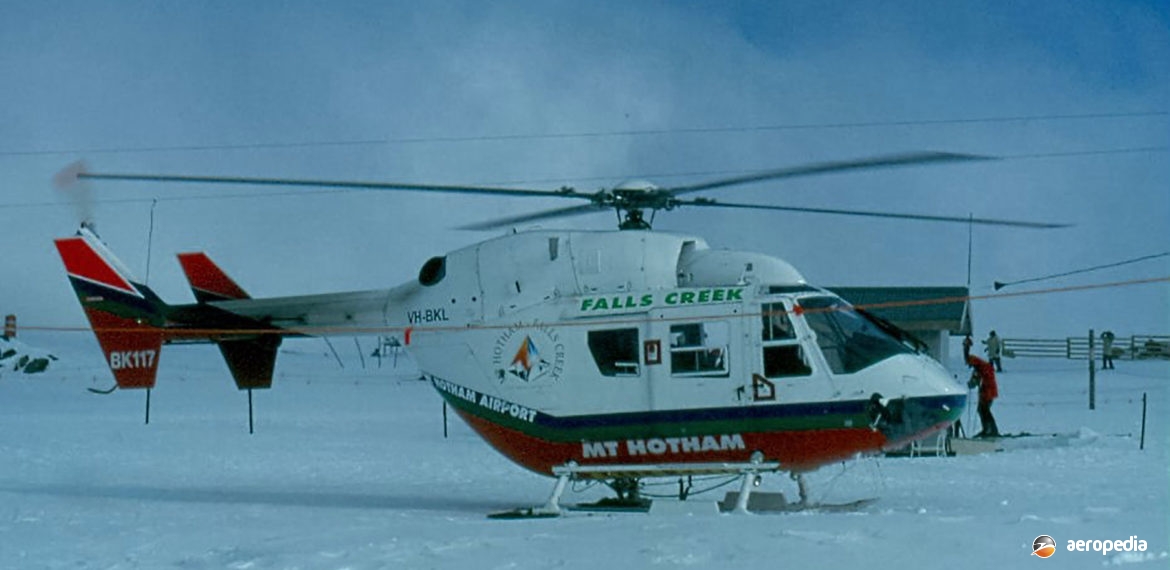Photograph:
MBK-117B-2 VH-BKL (c/n 1087) at Falls Creek in the Victorian ski fieldscin July 2003 (David C Eyre)
Country of origin:
Germany and Japan
Description:
Multi-purpose helicopter
Power Plant:
Two 448 kw (600 shp) Avco Lycoming LTS 101-650B-1 turboshafts
Specifications:
- Rotor diameter: 11 m (36 ft 1 in)
- Fuselage length: 9.88 m (32 ft 5 in)
- Height: 3.85 m (12 ft 8 in)
- Main rotor disc area: 95.0 m² (1,023 sq ft)
- Max speed at sea level: 275 km/h (171 mph)
- Cruising speed at sea level: 264 km/h (164 mph)
- Max rate of climb: 600 m/min (1,970 ft/min)
- Hovering ceiling in ground effect: 4,100 m (13,450 ft)
- Range with max payload: 545 km (339 miles)
- Empty weight: 1,520 kg (3,351 lb)
- Loaded weight: 2,800 kg (6,173 lb)
History:
The BK-117 helicopter was the result of a plan by Messerschmitt-Bolkow-Blohm and Kawasaki to jointly develop an eight to twelve seat multi-purpose helicopter. Following agreement, work commenced on the construction of four prototypes to complete the certification programme, one each for Germany and Japan, and two airframes for testing, one for tie-down tests and the other for static tests. The first aircraft (c/n P-2) was first flown at the MBB facility at Ottobrunn near Munich, Germany on 13 June 1979. This was followed by c/n P-3 at Kawasaki’s facility at Gifu near Nagoya, Japan on 10 August 1979.
Following certification, the decision was taken to place the type in production and within a few months orders for 120 examples had been received. Production was a joint effort, with MBB being responsible for constructing the main and tail rotor systems, the tail unit and hydraulic components, and Kawasaki constructing the fuselage, undercarriage, transmission, and some other components. The first production aircraft was delivered in mid-1981 and development proceeded towards increasing the range of tasks the machine could complete. Roles it was designed to fill included general utility work, offshore operations, medical evacuation, search and rescue, police work etc.
Power was provided by two Avco Lycoming turboshafts driving the well-proven Bolkow hingeless rotor system, as was used on the BO-105 series, the main rotor blades being of reinforced fibreglass construction. Accommodation was provided, when used as a passenger transport, for eight to ten persons seated in two triple benches, two individual seats for pilots, or pilot and passenger, and an optional twin-seat, facing aft, in the rear of the cabin. A number of quick-change units allowed the mission to be changed, and doors in the rear of the fuselage gave access to the cargo compartment allowing stretchers to be loaded and unloaded in the ambulance role.
The structure was designed with a single-curvature on major structural components, using riveted semi-monocoque aluminium constructed with several bonded aluminium-sandwich panels, and compound curvatures were limited to secondary structural components, which were sandwiched panels with Kevlar skins. Initial production aircraft were the BK 117 A-1, which was followed by the A-3 with a higher max take-off weight and an enlarged tail rotor. In 1987 the BK 117 A-4 introduced increased performance and an improved tail rotor. In 1987 the BK 117 B-1 appeared with more powerful AlliedSignal LTS 101-750B-1 engines, and later the B-2 with an increased max take-off weight. The BK 117 C-2 was a development in Germany and was fitted with Turbomeca Arriel engines.
A variant of the type has becoming known as the BK 117 850D-2, this involving the replacement of the engines with Honeywell LTS-850D-2 engines to improve performance. A number have been converted in Germany by ADAC, a similar conversion being carried out by AirWork the aircraft in late 2019 becoming ZK-IFL. This machine was built in 1986 and became D-HBNV, later EC-EVT, D-HMBF and D-HDPS before shipment to New Zealand. The Honeywell engine increases max OEI hover weight. This model received European EASA certification in March 2012, Canadian certification in May 2013 and US FAA certification in April 2014.
The type has proved quite popular in this region, especially in the ambulance and medical rescue role, and has been used as a fire bomber with Bambi Buckets during times when the requirement for this type of machine in this role has been needed. Models registered have included the A-3, A-4, B-1 and B-2.

